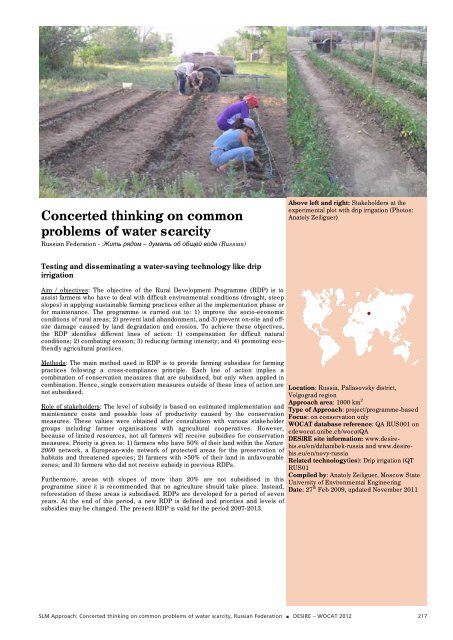Desire for Greener Land
Desire for Greener Land
Desire for Greener Land
Create successful ePaper yourself
Turn your PDF publications into a flip-book with our unique Google optimized e-Paper software.
Concerted thinking on common<br />
problems of water scarcity<br />
Russian Federation - :Жить рядом – думать об общей воде (Russian)<br />
Testing and disseminating a water-saving technology like drip<br />
irrigation<br />
Aim / objectives: The objective of the Rural Development Programme (RDP) is to<br />
assist farmers who have to deal with difficult environmental conditions (drought, steep<br />
slopes) in applying sustainable farming practices either at the implementation phase or<br />
<strong>for</strong> maintenance. The programme is carried out to: 1) improve the socio-economic<br />
conditions of rural areas; 2) prevent land abandonment, and 3) prevent on-site and offsite<br />
damage caused by land degradation and erosion. To achieve these objectives,<br />
the RDP identifies different lines of action: 1) compensation <strong>for</strong> difficult natural<br />
conditions; 2) combating erosion; 3) reducing farming intensity; and 4) promoting ecofriendly<br />
agricultural practices.<br />
Methods: The main method used in RDP is to provide farming subsidies <strong>for</strong> farming<br />
practices following a cross-compliance principle. Each line of action implies a<br />
combination of conservation measures that are subsidised, but only when applied in<br />
combination. Hence, single conservation measures outside of these lines of action are<br />
not subsidised.<br />
Role of stakeholders: The level of subsidy is based on estimated implementation and<br />
maintenance costs and possible loss of productivity caused by the conservation<br />
measures. These values were obtained after consultation with various stakeholder<br />
groups including farmer organisations with agricultural cooperatives. However,<br />
because of limited resources, not all farmers will receive subsidies <strong>for</strong> conservation<br />
measures. Priority is given to: 1) farmers who have 50% of their land within the Nature<br />
2000 network, a European-wide network of protected areas <strong>for</strong> the preservation of<br />
habitats and threatened species; 2) farmers with >50% of their land in unfavourable<br />
zones; and 3) farmers who did not receive subsidy in previous RDPs.<br />
Furthermore, areas with slopes of more than 20% are not subsidised in this<br />
programme since it is recommended that no agriculture should take place. Instead,<br />
re<strong>for</strong>estation of these areas is subsidised. RDPs are developed <strong>for</strong> a period of seven<br />
years. At the end of this period, a new RDP is defined and priorities and levels of<br />
subsidies may be changed. The present RDP is valid <strong>for</strong> the period 2007-2013.<br />
Above left and right: Stakeholders at the<br />
experimental plot with drip irrigation (Photos:<br />
Anatoly Zeiliguer)<br />
SLM Approach: Concerted thinking on common problems of water scarcity, Russian Federation DESIRE – WOCAT 2012<br />
Location: Russia, Pallasovsky district,<br />
Volgograd region<br />
Approach area: 1000 km 2<br />
Type of Approach: project/programme-based<br />
Focus: on conservation only<br />
WOCAT database reference: QA RUS001 on<br />
cdewocat.unibe.ch/wocatQA<br />
DESIRE site in<strong>for</strong>mation: www.desirehis.eu/en/dzhanibek-russia<br />
and www.desirehis.eu/en/novy-russia<br />
Related technology(ies): Drip irrigation (QT<br />
RUS01<br />
Compiled by: Anatoly Zeiliguer, Moscow State<br />
University of Environmental Engineering<br />
Date: 27 th Feb 2009, updated November 2011<br />
217









